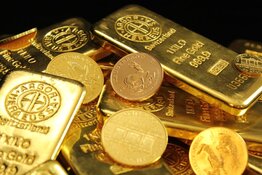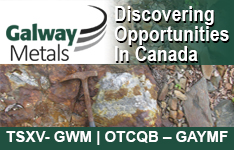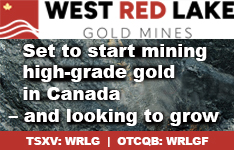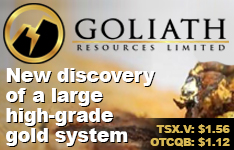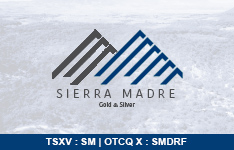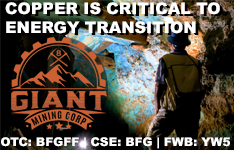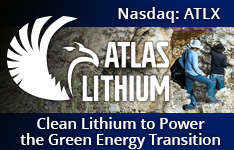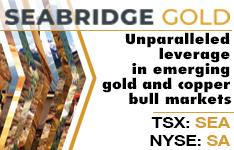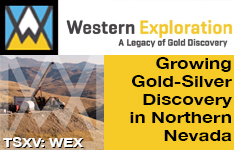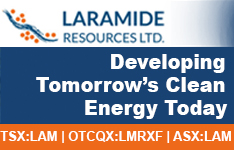Gold rose more than 60% this year, cracking the US$4,300 barrier for the first time. It has since cooled into correction territory at and was US$4,073.77 at the time of writing.
Some may wonder if the pullback means the end of this bull market, but Global Analyst Adrian Day told Streetwise Reports believes that the current prices are "definitely not the top."
"It's not 2011 and it's not 1980, which were the last gold peaks, of course, the peaks that have ended the gold runs in the last 50 years," Day said in an interview covering the sector. "And I say that for several reasons. One reason is that, although obviously in September and October, we got very, very excited. Every day, gold was up and, you know, another US$100 hurdle fell, another US$100 hurdle fell. And we got very excited about it. But we're talking about an asset of US$3,600, US$4,000. So, US$100 means nothing compared with what it meant in 1980."
The price of gold has set many records this year, but it took on new significance when the rally passed through an inflation-adjusted peak set on Jan. 21, 1980, when prices topped out at US$850.
While definitely exciting for goldbugs, it puts the current rally in perspective, he said.
"If you look at a 100-year or 60-year gold chart on a log basis and look at the percentage gains, then the last three years or last two years in gold, whenever you want to start this rally, are . . . meaningfully lower and less than the 2010-2011 rally. And the 1979-1980 rally. But on a percentage basis, the rally is not one for the history books yet."
A Bump on the Bull Market Highway
That situation this year has been quite different from 2011, when there was a consistent increase in flows into the GDX throughout the year, Day noted. It reached its peak in August and September, coinciding with the peak in gold prices. At that time, the GDX was trading at a premium, which steadily rose in June, July, August, and September. These are the indicators you want to observe and then consider how often gold is a headline on CNBC.
"Back in 2011, it was," Day said. "Again, we have no signs of mania . . . You simply cannot, by definition, have a market top without public participation. We simply didn't have any."
Day said it may just be a bump in the bull market highway and that he is convinced that gold has not reached its top.
"You often get these sharp pullbacks during bull markets," he told Streetwise. "How long could this last? I mean, the recovery has actually been quite encouraging . . . It's always good when the market has a proper correction."
How deep could the correction go if it continues? Day said he predicted a worst-case scenario of US$3,250.
"A lot of support there because that's where gold traded, in a very narrow range from the end of April to the end of August," he said. "I honestly don't think we'll get back there. I would think US$3,600 would be a peak at bottom."
All of the reasons why people have been buying gold in the last year "are still intact," he said. "Nothing has gone away. Nothing is diminished."
The Preferred Save-Haven Asset
For centuries, gold has been the preferred safe-haven asset during periods of political and economic instability, according to authors Jack Ryan and Yvonne Yue Li writing for Bloomberg on October 21.
Its reputation as a consistently high-value commodity, easily transportable and sellable worldwide, provides a sense of security when other markets are in disarray.
The world's central banks have been increasing their gold reserves, and investors have turned to gold for protection this year amid President Donald Trump's escalating trade war, record U.S. debt levels raising concerns about the nation's fiscal health, and increasing threats to the Federal Reserve's independence, they noted. As investors flocked to gold-backed exchange-traded funds, total holdings reached their highest level in over three years in October, according to Bloomberg data.
Day also said the central bank trend has been a long-term one that "didn't start with Donald Trump, and it's probably not going to end with Donald Trump."
"I think it's fair to say that nothing that this administration has done has eased the concerns about global foreign policy, of central banks, whose main asset is still the dollar," the expert said. "
But during this bull run with the government shutdown and "no efforts to control the deficit," foreign banks "want to step up and move out of the dollar."
"The question I would ask is: if you're Saudi Arabia, if you're United Arab Emirates, if you're China, is 48% of your assets in the dollar still too much? I would argue it is," Day said.
What could cause gold to drop significantly? "What's going to cause gold to drop significantly would be if the U.S. administration decides to have a balanced budget. If Trump and the rest of them come out and say, 'You know what? We were only kidding, guys. We really like you. Forget about the tariffs."
If gold moves back up to US$4,200, there will be people who say, "I'd better buy it before it goes up anymore."
"If it then goes to (US$4,200) and then goes to (US$4,300), people are going to say, if they're standing on the sidelines, they're going to say, 'I'd better jump in before I miss it again,'" Day said. "Remember, people on the sidelines, by definition, are people who missed it the first time around. So, they don't want to miss it the second time around."
Great Opportunities
The analyst said there are great opportunities for investors new to the sector or those who are under-invested.
"I definitely think one should be buying, definitely," he said. "There are some really good quality companies at good prices. Not as good as they were a year ago, but at good prices. And prices, frankly, we may not see again."
How to start? Day said to take small positions in "the best of the best," like Agnico Eagle Mines Ltd. (AEM:TSX; AEM:NYSE) or Franco-Nevada Corp. (FNV:TSX; FNV:NYSE), some of the largest mining companies in the world.
Agnico Eagle's price at the time of the interview was within 25% of its lowest valuations in its entire history, according to Day.
As the price of gold moves up, the value of the company moves up, as well, he said.
"I would definitely start by taking positions, maybe 50, half positions or whatever, depending on whether you're conservative or aggressive," Day continued. "But take positions in the best of the best to begin with."
Intermediate producers would be next on the list, and "potentially one of the strongest sectors in the next 12 to 18 months."
"When a bull market starts, typically investors move into the big-cap stocks first," he said. "Then the money starts to come down the chain. The next place they go to is intermediate producers . . . There's always a potential for M&A for these companies, but even without that, I think that's where you're seeing a lot of value now."
Look at Jurisdictions, But 'Troubled' Cos. Could Be Opportunities
Equinox Gold Corp. (EQX:TSX; EQX:NYSE.A), which Day said was a "troubled" company a year ago with delays and cost overruns, recently released its third-quarter 2025 results, reporting quarterly sales of US$819.01 million and net income of US$85.58 million, both significantly higher than the same period last year, according to a Simply Wall St. report.
"Even though the stock's moved up a lot, it's almost tripled from those depressed flows when people were just dumping it because of the problems, it is, on a peer basis, considerably undervalued," Day said.
Also investigate the country and the jurisdiction for a company's major gold projects, he said. For example, a new mining code implemented in Mali in 2023 increased state and local ownership of the mines and raised royalties, creating uncertainty for some foreign investors. In that case, it's very important to research the experience of the company's leadership team, to see if they have successfully navigated such rough waters in the past.
Equinox has such a team, he noted, and so does Fortuna Mining Corp. (FSM:NYSE; FVI:TSX; FVI:BVL; F4S:FSE), which last month released a preliminary economic assessment (PEA) on its planned next mine, the Diamba Sud project in Senegal, that shows a payback of capital in less than one year. Using a gold price of US$2,750, the IRR is 72% and the payback is 0.8 years, with a low capex of US$283 million. Low all-in sustaining costs (AISC) estimated at US$1,238 will lower the company-wide cost profile. Another company he mentioned was B2Gold Corp. (BTG:NYSE; BTO:TSX; B2G:NSX), which this summer announced its first gold pour at its Goose Mine in the Black River Gold District in Nunavut, Canada.
"When you're looking at riskier jurisdictions . . . two things that matter to me," Day said. "One is, is there an actual long-term . . . mining industry and mining history? Do you have people in that country who are experienced in mining, who know what mining means to the country, who know what mining means in terms of employment?"
M&A Not His Target, But 'Icing on the Cake'
Among smaller cap companies, Day said he liked royalty companies like Elemental Royalties Corp. (ELE:TSX.V; ELEMF:OTCMKTS) and Metalla Royalty & Streaming Ltd. (MTA:TSX.V; MTA:NYSE American) and companies with either strong balance sheets or cash flow or shareholders who are always be "there for them."
Another is Orogen Royalties Inc. (OGN:TSXV; OGNNF:OTC), which has an almost US$20 million balance sheet, "a lot for a prospect generator," he said. They "don't have to raise money to dilute unless it's for a good opportunity," he said. "But they don't have to. That's the key."
Pay attention to the shareholders and look for big names in the industry, like geologist and entrepreneur Ross Beaty, he said.
Another smaller-cap company worth watching is Heliostar Metals Ltd. (HSTR:TSX.V; HSTXF:OTC; RGG1:FRA), which is "to the point where they now have three producing mines" with minimal dilution and strong shareholders.
Day said he also doesn't chase M&A deals but considers them to be "icing on the cake."
Often, the larger companies will wait until the smaller companies have done a lot of the work, like permitting and dealing with residents and First Nations.
"They're more prepared to pay up when the time is right than to get it cheap," the analyst said. "And you just saw that, for example, with Probe. Probe Mine was acquired by or is in the process of being acquired by Fresnillo Plc (FNLPF:OTCMKTS:FRES:LSE)."
Day said it was a surprise for him, as the "betting in the market" was that Agnico would buy it. Fresnillo's purchase was "a bit of a surprise to me, frankly."
No Fear of the US Running Out of Gold Soon
While other metals like silver and copper have been added to the nation's critical minerals list because of their use in electronics and industry, he said they were "meaningfully more undervalued than gold."
Also, there is no shortage of gold production in the U.S., he said.
There's no fear that we're actually going to run out of gold in the United States," Day continued. "What this administration has done, of course, is fast-track the permitting."
While he said he agrees with geologist and San Cristobal Mining Inc. Chief Executive Officer Quinton Hennigh that the cycle of capital may have left the industry in need of a new generation of workers and experts, he believed the pendulum would "swing the other way."
"You get gold to US$5,000 or US$6,000, suddenly more and more people want to do geology," he said.
'Know Yourself'
Overall, the analyst said it was important for investors — new ones and experienced ones alike — to "know yourself, know what kind of risk you can tolerate, not just financially, but emotionally. There are a lot of people who say, 'I can take a risk. I don't care if stocks drop.' But as soon as they drop, they freak out."
Also, he said many people buy too many stocks.
"You shouldn't be building a collection," he said. "It's not like buying books that go on the bookshelf and half of them you never read."
It's also important to find reputable places to find research. "If you don't even know the basics about a company, and you don't know where you heard about it, then you shouldn't own it," he said. "Make sure you get your recommendations from people you can trust."
Important Disclosures:
- As of the date of this article, officers, contractors, shareholders, and/or employees of Streetwise Reports LLC (including members of their household) own securities of Agnico Eagle Mines Ltd., Franco-Nevada Corp., Equinox Gold Corp., Fortuna Mining Corp., B2Gold Corp., Metalla Royalty & Streaming Ltd., Orogen Royalties Inc., and Heliostar Metals Ltd.,
- Steve Sobek wrote this article for Streetwise Reports LLC and provides services to Streetwise Reports as an employee.
- This article does not constitute investment advice and is not a solicitation for any investment. Streetwise Reports does not render general or specific investment advice and the information on Streetwise Reports should not be considered a recommendation to buy or sell any security. Each reader is encouraged to consult with his or her personal financial adviser and perform their own comprehensive investment research. By opening this page, each reader accepts and agrees to Streetwise Reports' terms of use and full legal disclaimer. Streetwise Reports does not endorse or recommend the business, products, services or securities of any company.
For additional disclosures, please click here.

